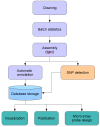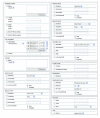Generation and analysis of a 29,745 unique Expressed Sequence Tags from the Pacific oyster (Crassostrea gigas) assembled into a publicly accessible database: the GigasDatabase
- PMID: 19640306
- PMCID: PMC2907693
- DOI: 10.1186/1471-2164-10-341
Generation and analysis of a 29,745 unique Expressed Sequence Tags from the Pacific oyster (Crassostrea gigas) assembled into a publicly accessible database: the GigasDatabase
Abstract
Background: Although bivalves are among the most-studied marine organisms because of their ecological role and economic importance, very little information is available on the genome sequences of oyster species. This report documents three large-scale cDNA sequencing projects for the Pacific oyster Crassostrea gigas initiated to provide a large number of expressed sequence tags that were subsequently compiled in a publicly accessible database. This resource allowed for the identification of a large number of transcripts and provides valuable information for ongoing investigations of tissue-specific and stimulus-dependant gene expression patterns. These data are crucial for constructing comprehensive DNA microarrays, identifying single nucleotide polymorphisms and microsatellites in coding regions, and for identifying genes when the entire genome sequence of C. gigas becomes available.
Description: In the present paper, we report the production of 40,845 high-quality ESTs that identify 29,745 unique transcribed sequences consisting of 7,940 contigs and 21,805 singletons. All of these new sequences, together with existing public sequence data, have been compiled into a publicly-available Website http://public-contigbrowser.sigenae.org:9090/Crassostrea_gigas/index.html. Approximately 43% of the unique ESTs had significant matches against the SwissProt database and 27% were annotated using Gene Ontology terms. In addition, we identified a total of 208 in silico microsatellites from the ESTs, with 173 having sufficient flanking sequence for primer design. We also identified a total of 7,530 putative in silico, single-nucleotide polymorphisms using existing and newly-generated EST resources for the Pacific oyster.
Conclusion: A publicly-available database has been populated with 29,745 unique sequences for the Pacific oyster Crassostrea gigas. The database provides many tools to search cleaned and assembled ESTs. The user may input and submit several filters, such as protein or nucleotide hits, to select and download relevant elements. This database constitutes one of the most developed genomic resources accessible among Lophotrochozoans, an orphan clade of bilateral animals. These data will accelerate the development of both genomics and genetics in a commercially-important species with the highest annual, commercial production of any aquatic organism.
Figures




Similar articles
-
GigaTON: an extensive publicly searchable database providing a new reference transcriptome in the pacific oyster Crassostrea gigas.BMC Bioinformatics. 2015 Dec 2;16:401. doi: 10.1186/s12859-015-0833-4. BMC Bioinformatics. 2015. PMID: 26627443 Free PMC article.
-
Generation and analysis of ESTs from the eastern oyster, Crassostrea virginica Gmelin and identification of microsatellite and SNP markers.BMC Genomics. 2007 Jun 8;8:157. doi: 10.1186/1471-2164-8-157. BMC Genomics. 2007. PMID: 17559679 Free PMC article.
-
Construction of a chromosome-level genome and variation map for the Pacific oyster Crassostrea gigas.Mol Ecol Resour. 2021 Jul;21(5):1670-1685. doi: 10.1111/1755-0998.13368. Epub 2021 Apr 18. Mol Ecol Resour. 2021. PMID: 33655634
-
A review of the major penaeid shrimp EST studies and the construction of a shrimp transcriptome database based on the ESTs from four penaeid shrimp.Mar Biotechnol (NY). 2011 Aug;13(4):608-21. doi: 10.1007/s10126-010-9286-y. Epub 2010 Apr 17. Mar Biotechnol (NY). 2011. PMID: 20401624 Review.
-
Redox control of antioxidants, metabolism, immunity, and development at the core of stress adaptation of the oyster Crassostrea gigas to the dynamic intertidal environment.Free Radic Biol Med. 2024 Jan;210:85-106. doi: 10.1016/j.freeradbiomed.2023.11.003. Epub 2023 Nov 11. Free Radic Biol Med. 2024. PMID: 37952585 Review.
Cited by
-
Transcriptomic Analysis of Differentially Expressed Genes During Larval Development of Rapana venosa by Digital Gene Expression Profiling.G3 (Bethesda). 2016 Jul 7;6(7):2181-93. doi: 10.1534/g3.116.029314. G3 (Bethesda). 2016. PMID: 27194808 Free PMC article.
-
Physiological change under OsHV-1 contamination in Pacific oyster Crassostrea gigas through massive mortality events on fields.BMC Genomics. 2013 Aug 29;14:590. doi: 10.1186/1471-2164-14-590. BMC Genomics. 2013. PMID: 23987141 Free PMC article.
-
Pyrosequencing of Haliotis diversicolor transcriptomes: insights into early developmental molluscan gene expression.PLoS One. 2012;7(12):e51279. doi: 10.1371/journal.pone.0051279. Epub 2012 Dec 7. PLoS One. 2012. PMID: 23236463 Free PMC article.
-
mRNA-Seq and microarray development for the Grooved Carpet shell clam, Ruditapes decussatus: a functional approach to unravel host-parasite interaction.BMC Genomics. 2013 Oct 29;14:741. doi: 10.1186/1471-2164-14-741. BMC Genomics. 2013. PMID: 24168212 Free PMC article.
-
RNA-Seq in Mytilus galloprovincialis: comparative transcriptomics and expression profiles among different tissues.BMC Genomics. 2015 Sep 24;16(1):728. doi: 10.1186/s12864-015-1817-5. BMC Genomics. 2015. PMID: 26400066 Free PMC article.
References
-
- Cunningham C, Hikima J, Jenny MJ, Chapman RW, Fang GC, Saski C, Lundqvist ML, Wing RA, Cupit PM, Gross PS. et al.New resources for marine genomics: bacterial artificial chromosome libraries for the Eastern and Pacific oysters (Crassostrea virginica and C. gigas) Mar Biotechnol (NY) 2006;8(5):521–533. doi: 10.1007/s10126-006-6013-9. - DOI - PubMed
-
- Saavedra C, Bachère E. Bivalve genomics. Aquaculture. 2006;256(1–4):1–14. doi: 10.1016/j.aquaculture.2006.02.023. - DOI
Publication types
MeSH terms
LinkOut - more resources
Full Text Sources
Research Materials

